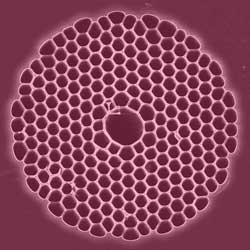Holey Fibers Shed New Light

A holey fiber may be able to plug the “holes” in the list of laser colors affordable to most scientists. Biomedical researchers would like small and cheap lasers producing ultraviolet light for cancer detection and other types of tissue analysis. Now a team reports in the 17 September PRL that it has developed a simple device to convert commonly available laser light into these and other wavelengths. The converter is a hollow optical fiber made of a so-called photonic crystal material and filled with hydrogen gas. It is more efficient and requires a million times less power from the input laser than any such converter previously made.
Common diode lasers–the type used in laser pointers and grocery-store scanners–are cheap laboratory workhorses for colors ranging from orange to infrared. But for some wavelengths outside that range, lasers are much more expensive and cumbersome, so researchers would like to easily convert diode laser light to other wavelengths.
One way to convert laser light is to pass it through a so-called Raman gas such as hydrogen. A gas molecule absorbs the “pump” laser’s photon, uses some of the energy to vibrate or rotate, and then spits out the rest as a new photon with a longer wavelength. The new photon, with help from a second pump photon, then “stimulates” the Raman process in another molecule, which generates a second wavelength-shifted photon whose electric field is synchronized with the first. Those two photons continue to create others in this way, ultimately generating a new beam. The Raman process can also produce light with shorter wavelengths if the gas molecules donate energy to the photons instead of absorbing it.
But common diode lasers don’t produce enough photons for all those two-photon collisions–at least using conventional Raman technology. A team led by Philip Russell of the University of Bath in England recently demonstrated a new principle for an efficient, low-power Raman converter [1] and now they have dramatically improved its performance. The light travels through the 7-micron-diameter hollow core of a 50-micron-wide photonic crystal fiber made from glass tubes fused together lengthwise in a honeycomb pattern. The holey pattern acts as a “corral” that keeps a narrow range of wavelengths from escaping the core, while letting other wavelengths out. The researchers filled the core with hydrogen and sent pulses of infrared laser light through it.
The team’s 35-meter-long fiber required only 4 watts of pump laser power to generate a measurable Raman-shifted beam, compared with more than a megawatt needed for conventional systems. Because the pump laser’s light remains focused in a very narrow beam inside the fiber, it does not need to supply so many photons. And with a long fiber, each pump photon has lots of opportunities to interact with gas molecules. “This [power level] should be accessible to anyone,” says Bath team member Fetah Benabid. Using a different setup, Benabid and his colleagues also recorded the highest efficiency ever reported–92 percent of the pump photons generated Raman-shifted photons.
All of the ingredients for this wavelength converter are comparatively cheap, Benabid says. By selecting the right fiber, Raman gas, and pump laser, “you can cover the whole spectrum from ultraviolet to the far infrared,” he says.
“There’s a definite need for small, compact ultraviolet sources in the biomedical field,” says Joseph Gardecki of the Massachusetts Institute of Technology. Such a source could make cancer detection more affordable and portable, he says.
–Chelsea Wald
In 2006 Chelsea Wald was a science writing intern at APS. Now she is a freelance science writer in the Netherlands and the author of Pipe Dreams: The Urgent Global Quest to Transform the Toilet (Simon & Schuster, 2021).
References
- F. Benabid et al., “Stimulated Raman Scattering in Hydrogen-Filled Hollow-Core Photonic Crystal Fiber,” Science 298, 399 (2002)
More Information
website on photonic crystal fibers from the University of Bath


